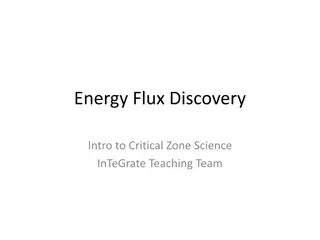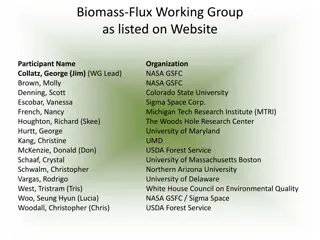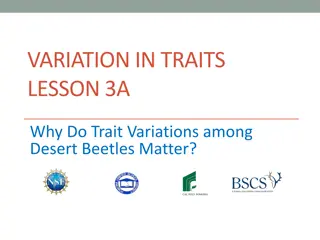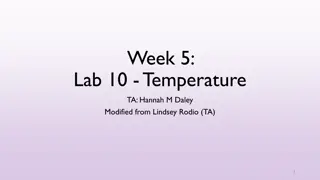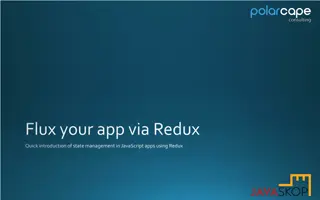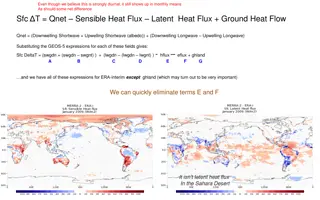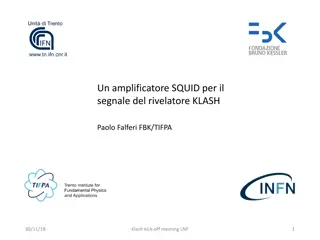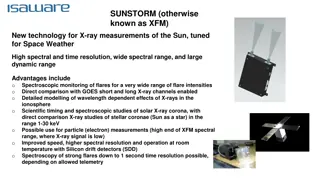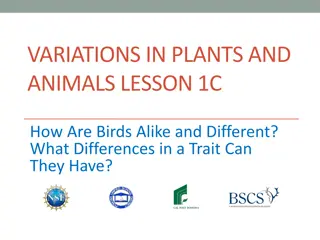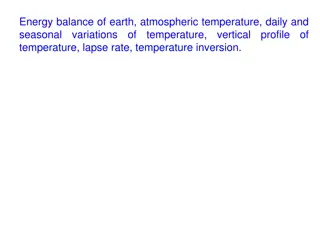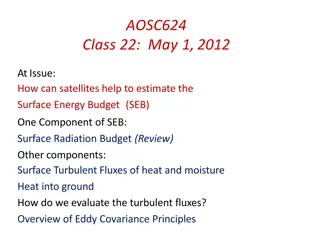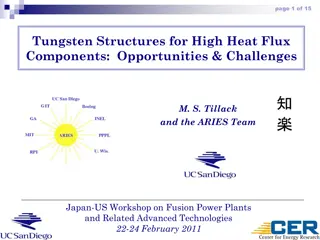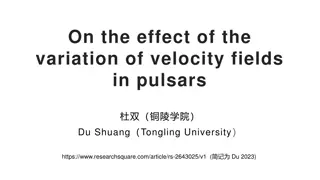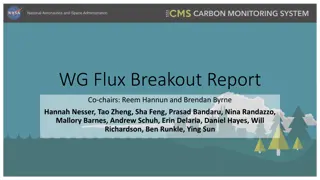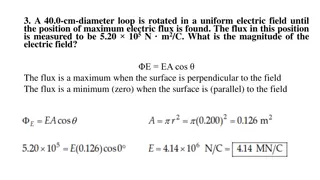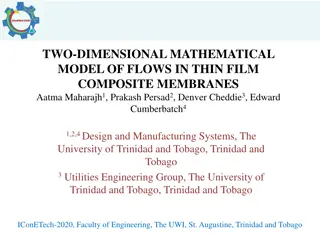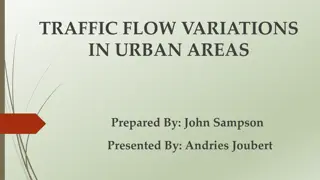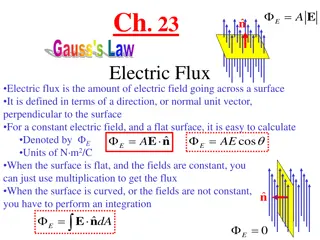AGN Jet Production Efficiency: Insights from Spin and Magnetic Flux
A fundamental question in astrophysics is how efficiently active galactic nuclei (AGN) produce jets. Black hole spin and magnetic flux play crucial roles in determining the jet production efficiency. High-spin values and large magnetic flux threading are essential for generating high-efficiency jets
2 views • 22 slides
Review of Critical Heat Flux in Liquid Hydrogen, Methane, and Oxygen
This review paper presents data and predictive tools on the critical heat flux (CHF) of liquid hydrogen, methane, and oxygen. It covers the motivation for CHF modeling, background on pool and flow boiling curves, availability of CHF data for different liquids, and applications in space propulsion sy
0 views • 15 slides
Metabolic Control Mechanisms in Cellular Regulation
Metabolic control mechanisms play a crucial role in maintaining homeostasis within cells by regulating metabolic pathways. This involves finely adjusting the output of pathways in response to external signals, ensuring the proper flux of metabolites to meet cellular needs. Pacemaker enzymes, such as
2 views • 17 slides
IWG Measurement Uncertainties: Justification of Impact Quantities
Explore the justification of main impact quantities in IWG Measurement Uncertainties session held on 6th and 7th October 2020. The analysis includes factors such as deviation from centered driving, start of acceleration, speed variations, load variations, background noise, temperature effects on noi
3 views • 25 slides
Secondary Clarifiers in Wastewater Treatment
Secondary clarifiers play a crucial role in wastewater treatment processes by producing clarified effluent and concentrating biological solids. This involves settling tanks following trickling filters and suspended growth processes, each with specific objectives. Column and continuous flow analyses
0 views • 10 slides
Isotope Production Charged Particle Cross Section Techniques
The process of measuring angle-integrated charged-particle cross sections using the stacked target technique is discussed. The method involves the use of monitor foils, degraders, and a beam foil of interest to determine energy and flux. Uncertainties in the measurements and the correction for flux
1 views • 3 slides
Application of CMS-Flux System for Carbon Flux Inventories Evaluation
Preparation for the global CMS Flux system integration with US forest and agricultural carbon inventory data to quantify uncertainties and enhance inventory-relevant flux estimates. The project aims to evaluate the utility of CMS-Flux-NA system for top-down assessment of US agricultural and forest C
2 views • 21 slides
Magnetic Flux and Induced Current in Loops
Explore concepts related to magnetic flux and induced current in loops through visual scenarios involving uniform magnetic fields, loop movements, and changes in magnetic flux. Test your understanding with multiple-choice questions on induced EMF, loop bending, and maximizing magnetic flux. Enhance
1 views • 54 slides
Deconvolving Snow Cover and Snowfall Passive Microwave Signals
This research focuses on deconvolving snow cover and snowfall passive microwave signals using GPM data. The study employs a data-driven approach to estimate snowfall using a nested K-nearest algorithm and observed irregularities. By analyzing variations in brightness temperatures (Tbs) over snow-cov
0 views • 9 slides
Retrieving Snowfall Rate from Satellite-Based W, Ka, and Ku Band Reflectivity Measurements
This study discusses methods for retrieving snowfall rate from satellite-based reflectivity measurements, specifically focusing on developing S-Z relationships through collocations and conservation of mass flux. It highlights the importance of identifying differences between retrieval products and t
0 views • 13 slides
Advanced Selective Soldering System with Flux Spray and Preheating Modules
The Selective Soldering System-M offers precise soldering capabilities with features like individual pot control, flux spray module for reduced contamination, and preheating module for lead-free and multi-layer boards. It minimizes flux consumption and ionic contamination while ensuring high positio
0 views • 6 slides
Pathological Differences in Hip Joint Variations: Abnormal Gait Analysis
Understanding pathological gait variations related to hip joint differences is crucial in gait analysis. Excessive sagittal, coronal, and transverse plane motions impact stance and swing phases, leading to deviations in gait patterns. Excess flexion, limited flexion, past retraction, excess adductio
0 views • 13 slides
Stellar Properties: Distance, Brightness, and Flux
Explore the fascinating realm of stellar astronomy with topics such as stellar parallax, magnitude scales, luminosity, radiant flux, and the inverse square law. Learn about measuring distances to stars, comparing their brightness, and understanding the energy they emit into space. Dive into the intr
0 views • 31 slides
Cumulus Parameterization and Mass-Flux Schemes in Atmospheric Science
Explore the significance of mass-flux schemes in cumulus parameterization, their interaction with grid-scale microphysics, and the key elements and assumptions involved. Learn about the objectives, components, and limitations of classical cumulus schemes for atmospheric modeling. Gain insights into
0 views • 23 slides
Importance of Rock v. MWB [2018] UKSC 24 as Explained by Lord Sumption
The case of Rock v. MWB [2018] UKSC 24 holds significant importance due to the ruling by Lord Sumption and the Supreme Court's decision regarding contract variations. It revolved around a dispute between MWB, a serviced office provider, and Rock Advertising over alleged contractual variations made o
0 views • 12 slides
Energy Flux in Critical Zone Science
Dive into the world of energy flux discovery in the critical zone science, understanding common water and energy fluxes, cloud formations, and tracking monthly Ameriflux energy fluxes in various forest environments. Engage with visual representations and data models to grasp the intricate balance of
0 views • 5 slides
ESA Cross-Support Activities Report October 2021
October 2021 witnessed various cross-support activities by ESA, including data exchange with JPL for flux calculation comparison, ESA-JAXA cross-support validation, and investigations into flux comparison issues. The report also highlights inconsistencies found in JAXA OBS files and provides updates
0 views • 7 slides
Biomass-Flux Working Group Overview
The Biomass-Flux Working Group, a collaboration involving various organizations like NASA and universities, aims to integrate land-atmosphere carbon fluxes and biomass changes to enhance estimations and understanding. By identifying overlapping projects, encouraging cross-comparisons, and reconcilin
0 views • 10 slides
Importance of Trait Variations in Desert Beetles
Exploring the significance of trait variations among desert beetles, this lesson delves into why variations matter and how they impact survival in the desert environment. Through activities and discussions, students analyze traits, predict beetle survival, and understand the implications of variatio
0 views • 10 slides
Factors Influencing Temperature Variations in US Cities
Solar zenith angle, location, specific heat, and axial tilt are key factors influencing temperature variations in US cities. Proximity to water bodies, altitude, and latitude also play significant roles. This lab explores why coastal cities experience different temperature patterns compared to inlan
0 views • 8 slides
SPC.CS Coil Design and Analyses: Requirements, Assumptions, and Methodology
This document discusses the design and analysis of SPC.CS coil, focusing on maximizing magnetic flux, survival under fatigue conditions, and materials used for different field layers. It covers requirements, assumptions, and the methodology for uniform current density solenoid design. The study aims
0 views • 15 slides
Magnetic Flux and Induction Principles
Exploring the concepts of magnetic flux and electromagnetic induction through visual aids and explanations. Topics include the generation of current in coils, Faraday's law, Lentz's law, and the behavior of induced current with changing flux.
0 views • 36 slides
Introduction to State Management with Flux and Redux in JavaScript Apps
Explore the concepts of Flux and Redux for efficient state management in JavaScript applications, understanding their architecture, key components, and benefits in simplifying data flow. Dive into the unidirectional data flow pattern of Flux and the inspired improvements in Redux, alongside the comp
0 views • 13 slides
Analysis of Surface Temperature and Heat Flux Relationships
Exploring the interplay between surface temperature, sensible heat flux, latent heat flux, and ground heat flow, utilizing data from GEOS-5 and ERA-interim models to understand the impact of different heat flux components on surface temperature variations in diurnal cycles and monthly means. Compari
0 views • 8 slides
Superconducting Quantum Interference Device (SQUID)
The Superconducting Quantum Interference Device (SQUID) is a crucial component for detecting signals in devices like the KLASH detector. By combining Flux Quantization and Josephson Tunneling, the SQUID operates based on key principles such as the Josephson Equations and the Flux Quantum. Through ca
0 views • 23 slides
SUNSTORM: Advanced X-ray Technology for Solar Measurements
SUNSTORM, also known as XFM, is a cutting-edge technology designed specifically for measuring X-rays from the Sun, tailored for Space Weather monitoring. It offers high spectral and time resolution, a wide spectral range, and a large dynamic range, making it ideal for various scientific studies rela
0 views • 4 slides
Bird Variations: A Comparative Study
Dive into the world of bird variations in this informative lesson discussing how birds are alike and different, the importance of traits, and exploring differences among bird species. Discover the concepts of variations and traits through engaging activities and observations.
0 views • 14 slides
Earth's Energy Balance and Temperature Variations
Earth's energy balance is crucial for maintaining atmospheric temperature and regulating daily and seasonal temperature changes. The net radiation, consisting of incoming shortwave and outgoing longwave radiation, plays a key role in this balance. Components such as sensible heat flux, latent heat o
0 views • 18 slides
Satellite Applications in Estimating Earth's Surface Energy Budget
Satellites play a crucial role in estimating the Surface Energy Budget (SEB) by providing data on various components such as Surface Radiation Budget and Surface Turbulent Fluxes. The SEB includes factors like net radiation flux, sensible and latent heat fluxes, and subsurface heat transfer. Satelli
0 views • 38 slides
Tungsten Structures for High Heat Flux Components: Opportunities & Challenges
Tungsten has a long history in fusion research, with applications in high-heat-flux components. He-cooled W structures offer performance advantages, such as high heat flux capability and good safety characteristics. Various design configurations and cooling schemes have been developed, with a focus
0 views • 15 slides
Pathway Analysis in Systems Biology
This article delves into the realm of pathway analysis in systems biology, focusing on methods such as embedding new pathways, enumeration of elementary flux modes, flux variations in metabolic networks, and identification of profitable networks. It explores strategies for optimizing metabolic pathw
0 views • 20 slides
Impact of Velocity Field Variations on Pulsar Magnetic Fields
The study explores how variations in velocity fields affect pulsar magnetic fields, highlighting the conversion of kinetic energy to magnetic energy in pulsars. Glitches in these systems can lead to changes in magnetic fields, influencing pulsar emissions. The maintenance of stable magnetic fields a
0 views • 14 slides
Flux Working Group Report and Synthesis Activities
The Flux Working Group, led by Co-chairs Reem Hannun and Brendan Byrne, focuses on quantifying carbon balance from point sources to global domains. Their goal is to provide data for understanding processes at various scales, developing models, and informing policy decisions. The group engages in var
0 views • 6 slides
Electric Field and Flux Calculations in Different Geometries
Explore various scenarios involving electric fields and flux calculations, such as finding the magnitude of electric fields in different situations, determining electric flux through surfaces, assessing net electric flux through charges in a submarine, and analyzing flux through faces of geometric s
0 views • 13 slides
Two-Dimensional Mathematical Model of Flows in Thin Film Composite Membranes
This study presents a mathematical model for flows in thin film composite membranes, focusing on the permeation of solvent flux and solute rejection. Assumptions include incompressible fluid, constant diffusion of chemical species, and isothermal conditions. Equations describe water flux, solute flu
0 views • 19 slides
Traffic Flow Variations in Urban Areas: A Comparative Study Between 1980 and 2015
This study compares the traffic flow variations in urban areas, focusing on average daily traffic totals, daily traffic volumes, and monthly variations between the years 1980 and 2015 in Johannesburg. Data collection locations, including traffic data from different sites and lanes, are presented alo
0 views • 20 slides
Exploring Glass Technology: Components, Roles, and Structures
In the realm of glass technology, understanding the components, roles, and structures is crucial. From the composition of glass to the functions of former, flux, and modifier, delve into the world of classical glass theory. Explore the ternary phase diagram, flux materials like Na2O and CaO, and the
0 views • 12 slides
Electronic Cleaning and Flux Removal Materials Market
The electronic cleaning and flux removal materials market is valued at $1.38 Billion in 2024 and is projected to grow at a CARG of 7.08% to reach $2.73 Billion by 2034. \n\nRead Report Overview: \/\/bisresearch.com\/industry-report\/electronic-cleani
1 views • 3 slides
Ch. 23
Gauss's Law in electromagnetism relates electric fields to electric charges. Electric flux, defined as the amount of an electric field crossing a surface, plays a crucial role in understanding the behavior of electric fields in various situations. This content delves into the principles of Gauss's L
0 views • 22 slides
Turbulent Heat Flux in Atmospheric Processes
Turbulent heat flux in atmospheric processes is explored through examples of eddy movement's impact on heat transport, showcasing scenarios where average turbulent flux can deviate significantly from zero. The interaction of eddies with temperature profiles and lapse rates influences the direction o
0 views • 4 slides
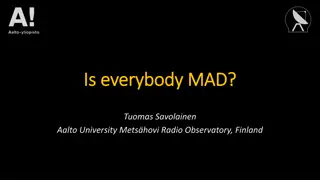
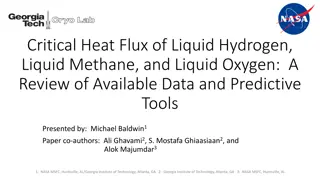
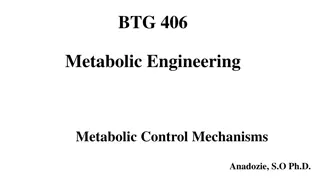


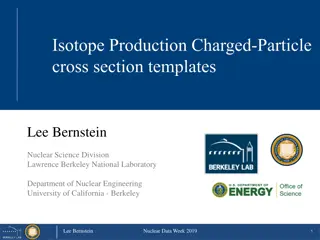
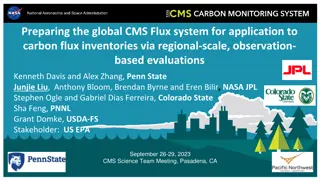

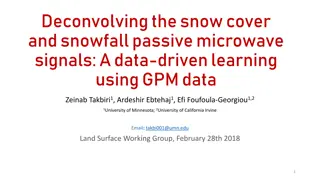
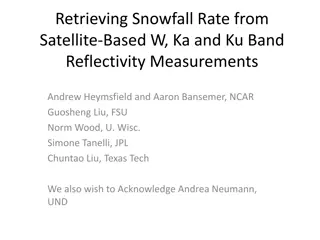
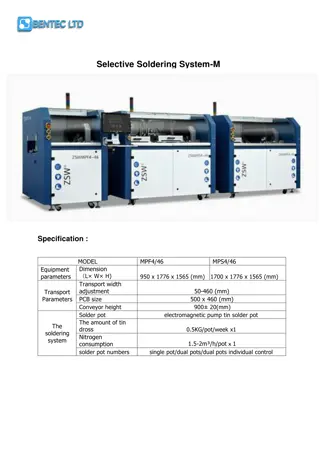
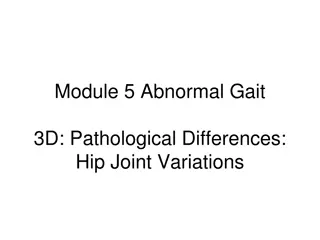
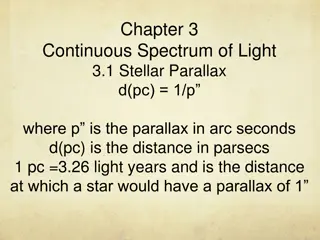
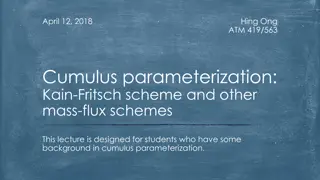
![Importance of Rock v. MWB [2018] UKSC 24 as Explained by Lord Sumption](/thumb/193348/importance-of-rock-v-mwb-2018-uksc-24-as-explained-by-lord-sumption.jpg)
